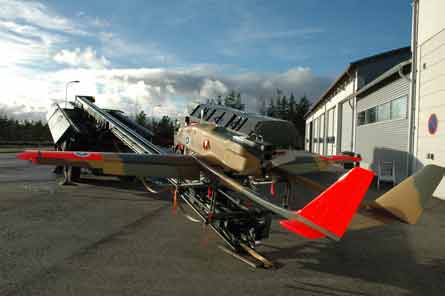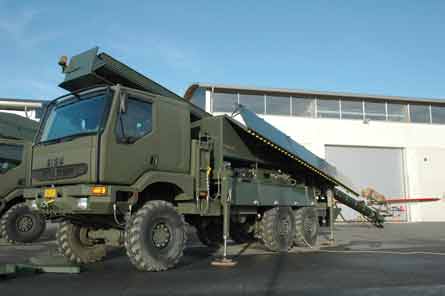The Finnish army has operated Israeli-designed Ranger UAVs for five years. It wants to widen their limited role, but must tackle regulatory and environmental issues
Five years after taking delivery of its first tactical unmanned air vehicles for use as an artillery spotting system, the Finnish army is exploring new roles for its Oerlikon Contraves-Ruag Ranger systems in joint-force operations, and is considering future missions to support civil authorities.
At the same time, the army is moving to overcome environmental and policy constraints on its ability to fly the Israeli-designed and Swiss-supplied UAV systems. In the past month, officials from the service's artillery reconnaissance battalion UAV battery have begun talks with civil and military air traffic authorities about revising arrangements for airspace access.
|
|---|
Finland's army selected the Ranger in September 1999 |
The battery, at Niinisalo, north-west of Finland's second largest city, Tampere, is also about to build the first-ever dedicated UAV runway at its base. That seemingly small step will dramatically change the way the battery trains by removing the need to deploy to a nearby civil airfield and hope for good weather when it wants to fly.
The harshness of Finland's environment remains a major influence on battery operations, acknowledges artillery reconnaissance battalion commander Lt Col Tapio Palmunen. It limits flying opportunities, but at the same time adds new dimensions to the operation of tactical systems, he says.
The emerging UAV focus on joint-force operations is dominated by Finnish navy requirements. Although this totals only one to two weeks of flying a year at present, says Palmunen, "the Finnish navy is one of our best customers".
Naval support operations are currently carried out on the Hanko naval training range on Finland's southern coastline and include a variety of maritime surveillance and reconnaissance mission types, including investigation of non-co-operative targets. "The UAV in this kind of area is very effective," says the battery's UAV pilot instructor, Capt Raine Lehtonen.
Finland began its search for a tactical UAV system in the early 1990s by testing two types developed by Israel Aircraft Industries (IAI). A summer demonstration of the IAI Pioneer took place in August and September 1991 and winter trials with the IAI-Oerlikon Contraves-Ruag ADS-90 system - the Ranger's predecessor - were held in January-March 1992. The trials resulted in an initial operational concept and performance requirements for an artillery-spotting UAV system, but budget pressures saw the project set aside until early 1996.
The Finnish army materiel command reactivated the requirement in March 1996, inviting 18 companies to submit proposals for a single system. Twelve responses were received. Tender evaluation produced a shortlist of four companies, which were invited to take part in a restricted tender process in June 1996 and a winter assessment campaign from January 1998. The candidates were Alliant Techsystems, offering Outrider the then Matra BAE Dynamics, offering Tucan/Brevel Oerlikon Contraves-Ruag, offering Ranger and Sagem, offering Sperwer.
Stand-out system
Alliant Techsystems withdrew from the competition before the flight assessment. Ranger rapidly emerged as a stand-out system, says Lehtonen, with operations conducted in air temperatures of -27.4°C (-17.3°F). "We gave them real missions to do," he says. "We had targets out there. We didn't tell them exactly what they had to find out and the result was that only Ranger at that time was able to perform all these flights."
A contract was signed with the Oerlikon Contraves-Ruag consortium on 29 September 1999 for a system of six air vehicles, with deliveries in 2001. A follow-on order for another system, again based on six vehicles, was signed on 22 September 2003, with deliveries completed in September 2005.
The current battery inventory comprises 11 air vehicles after one was lost in an accident in 2002 caused largely by inclement weather two ground control stations 11 Tamam MOSP electro-optic and infrared payloads four automatic landing systems two remote communications terminals three mobile receiver units and two Robonic MC3545H launchers.
The split acquisition has resulted in two different configurations of the equipment being fielded, although the two systems are fully interoperable. The six newest air vehicles carry an additional 50-60 litres (13-16 USgal) of fuel in bladders fitted into the inboard wing, raising their maximum take-off weight to 285kg (630lb).
The follow-on purchase also saw the introduction of Tamam's MOSP 770 colour electro-optic sensor payload, augmenting the existing Tamam MOSP 280, which uses a black-and-white daylight camera. Selection between the two sensor types depends on weather conditions, with the MOSP 280 producing better results in snowy conditions, says Capt Jaakko Makinen, the battery's image and survey instructor.
The follow-on acquisition was also used to introduce the Ruag Object Position and Tracking Sensor (OPATS) automatic landing system, a more capable version of the Ruag Range Automatic Positioning Sensor (RAPS) acquired with the first Ranger system, and a changeover of the primary datalink for both systems from L band to C band, with UHF as a back-up.
|
|---|
The army has two launchers for its 11 UAVs |
Lehtonen says the datalink change was driven by the rapid spread of mobile telephone technology across Finland, with the unit required to modify its communications systems in response. Specific channels have been reserved on C band for use by the UAV battery to prevent further encroachment by other user communities.
Introducing OPATS has played a key role in overcoming weather restrictions, says Makinen. Essentially, the system operates as a laser radar that lays down a readily identifiable glidepath for air vehicle recovery in visibility down to 1,200m (3,900ft), although the battery has demonstrated its successful operation in 1,000m visibility. OPATS also supports dual-wavelength operations, again helping to overcome bad weather.
Runway relief
The planned construction of a 250m runway at the Niinisalo base will ease training pressures on the battery. Current flying arrangements are based on use of a civilian airfield at Jami, with temporary airspace closures ensuring safety. That field is shared in the summer with general aviation, gliders, parachutists and model aircraft. In winter the general aviation community uses frozen lakes in the area to support ice operations, as well as continuing operations from the airfield. "It is not so easy to have airspace in this area," says Lehtonen. Coupled with the weather challenge, this means flying opportunities for the battery using the field are reduced to about 10 weeks a year.
The battery is currently permitted to fly in both controlled and non-controlled airspace across most of Finland by using a chase aircraft, or by applying for temporary closures, which take a minimum of six weeks to negotiate. For flying at the Finnish armed forces' four main training areas, the battery uses a combination of temporary airspace closures and military chase aircraft, depending on specific range conditions.
However, it is now exploring options for more flexible arrangements. Initial talks with Finnish authorities and the Finnish air force began in mid-November. "We have a certain hope to be able to use the temporary segregated areas which normally belong to the air force," says Lehtonen. "This was the first discussion about this issue and it will continue into early next year. If we are able to use these kinds of area, it means it will take only about eight days to activate the areas by using notices to airmen."
Parallel discussions are exploring the potential to reserve permanent airspace in the Jami area to help expand training flying.
The Ranger air vehicles are fitted with transponders and navigation lights as part of the battery's air traffic integration methodology. Consideration is being given to fitting an air traffic control relay to the UAV system communications suite.
More flexible airspace might allow the development of civil support missions for Finnish authorities, says Palmunen. The Swiss armed forces are now using their Ranger systems in such a role and this is being watched by the Finnish battery as a pointer for future roles. Air regulations already allow for emergency airspace access in the event of civil emergency, says Lehtonen, and this again highlights the need for an evolutionary approach between all parties.
Development of an appreciation of UAVs as a part of the aviation community is necessarily providing a step-by-step process, Lehtonen says. "We have to have good relationships with everyone who is dealing with UAVs."
In parallel. the battery itself has had to evolve its own awareness of aviation culture to ensure it can effectively engage with that wider community. Part of that understanding has flown directly from the Finnish air force, but the October 2002 crash has also played a role. That air vehicle was attempting to land when the accident occurred, and the subsequent investigation is now recognised by the battery as a turning point in its development.
"The main reason was the weather, and the other reason was the education level and experience of the battery," Lehtonen says. "This accident was good for the whole unit. Many things were changed. The air force people jumped in. The human factors were for the first time taken into account.
"But nowadays we know also ourselves something about these issues," he says, giving the battery its own experience base to work from. "Creating a new flying service is a long lasting process. We have done our lessons."
Source: Flight International





















